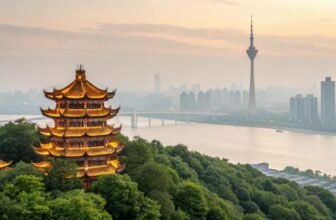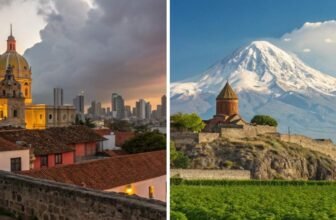
Something quietly powerful about staying put. In a world obsessed with checklists and constant movement, slow travel feels almost rebellious—like giving yourself permission to breathe, feel, and fully be somewhere.
It’s not about ticking off landmarks, but lingering over morning coffee in a place where time moves differently. The kind of journey where conversations matter more than selfies, and detours lead to stories you’ll tell forever.
If you’re craving a deeper connection to the world—and to yourself—these destinations will meet you there. Unpack once, settle in, and let the real magic unfold one slow, meaningful moment at a time.
1. Georgia (Caucasus)

Georgia has all the right ingredients for slow travel: soulful landscapes, deep-rooted traditions, and a tempo that invites you to linger. Whether you’re hiking through the wine-rich Kakheti region, getting to know locals in the quiet stone villages of Svaneti, or spending unhurried mornings sipping coffee in Tbilisi’s leafy courtyards, Georgia offers a refreshingly different rhythm.
One of the most powerful aspects of slow travel here is the way hospitality is embedded in the culture. It’s common to be invited in for a homemade feast with strangers, who don’t stay strangers for long. Every corner of this country—from remote monasteries perched on cliffs to quiet Black Sea towns—feels like it has a story, and if you give it time, it will unfold itself to you naturally.
This isn’t the kind of place to rush through a checklist. Georgia asks for patience, and in return, it reveals its charm in layers, like the amber hues of its unfiltered wines.
Quick Travel Notes for Georgia:
- Best Months to Visit: Late April–June and September–October
- Top Slow Travel Spots: Tbilisi, Svaneti, Kazbegi, Kakheti wine region
- Why It’s Great for 2025: Still under the radar but growing in popularity—go before the crowds arrive
- Local Experience to Try: Traditional “supra” feast with a local family and a toastmaster (tamada)
- Visa Info: Visa-free or easy e-visa access for most travelers
2. Tuscany, Italy

Tuscany is practically the definition of romantic slow travel. And no—it’s not just about the rolling vineyards and cypress trees (though those don’t hurt). There’s something about lingering over a three-hour lunch under the sun in a medieval hill town like Pienza, or wandering into a family-run trattoria where the menu changes daily based on grandma’s mood.
What makes Tuscany so rewarding for slow travel is how richly layered and hyper-local everything is. A neighboring village can feel like a world apart. The more you dig in—learning the difference between Chianti Classico and Brunello, understanding the rhythm of the olive harvest, stumbling upon a 14th-century festival—you realize Tuscany isn’t just beautiful, it’s deeply alive.
2025 is an especially great time to go slow here. With more eco-conscious agriturismos and cycling routes popping up, it’s easier than ever to connect with the land and people in a way that feels genuine and restorative.
Quick Travel Notes for Tuscany:
- Best Months to Visit: May–June and mid-September–October
- Top Slow Travel Spots: Val d’Orcia, Arezzo, Lucca, Chianti
- Why It’s Great for 2025: A resurgence of “quiet luxury” travel and rural retreats
- Local Experience to Try: Truffle hunting with a local farmer and dog
- Visa Info: Part of the Schengen Zone
3. Vietnam’s Central Highlands

Often skipped in favor of the coast or the north, Vietnam’s Central Highlands is a slow traveler’s dream. The region—stretching through towns like Da Lat, Buon Ma Thuot, and Kon Tum—is filled with coffee plantations, pine forests, and ethnic minority villages that feel far from the noise of Vietnam’s more tourist-heavy areas.
This is where Vietnam reveals a different personality—one of misty mornings, French villas overgrown with vines, and waterfalls cascading into quiet valleys. The food here, too, is unique. In Da Lat, for instance, you’ll find flavors influenced by its highland climate and French colonial past. And don’t rush that cup of coffee—it’s grown just down the road and best enjoyed slowly.
The Central Highlands rewards those willing to travel with curiosity and time. Whether you’re weaving through red-dirt roads on a scooter or chatting with elders in stilt-house villages, you’ll find moments of connection that aren’t easily found on an itinerary.
Quick Travel Notes for Central Highlands:
- Best Months to Visit: November–March (dry season)
- Top Slow Travel Spots: Da Lat, Pleiku, Buon Ma Thuot, Kon Tum
- Why It’s Great for 2025: A quieter, more authentic alternative to mainstream Vietnam hotspots
- Local Experience to Try: Stay in a longhouse and learn traditional crafts from local artisans
- Visa Info: E-visa available for many nationalities
4. São Tomé & Príncipe

Floating off the coast of West Africa like a secret garden, São Tomé & Príncipe offers a kind of remoteness that practically demands you slow down. With its lush jungles, empty black-sand beaches, and chocolate-scented air from old cacao plantations, it’s a place where time stretches in the best way.
There’s not much in the way of luxury resorts or fast-paced tours—and that’s the beauty of it. The vibe is raw, natural, and deeply rooted in the rhythms of island life. You hike, swim, nap, and eat fresh seafood. You let the island set the pace. And before you know it, you start to breathe differently.
For slow travelers seeking off-the-map serenity and unspoiled beauty, São Tomé & Príncipe is pure gold. It’s still remarkably untouched by mass tourism, so the people you meet are genuinely curious, the trails are uncrowded, and the experience feels deeply personal.
Quick Travel Notes for São Tomé & Príncipe:
- Best Months to Visit: June–September (dry season)
- Top Slow Travel Spots: São Tomé Island, Bom Bom, Obo National Park
- Why It’s Great for 2025: Still one of the least visited countries—ideal for nature-centric, crowd-free escapes
- Local Experience to Try: Visit a working cocoa plantation and take part in traditional roasting
- Visa Info: Some nationalities need visas; e-visa options available
5. Bosnia and Herzegovina

Tucked quietly into the Balkans, Bosnia and Herzegovina offers travelers the chance to step into a world where East meets West in the most unexpected ways. It’s a place of minarets and mountain churches, Ottoman bridges and Austro-Hungarian facades—and it’s all best appreciated slowly, on foot, with an open mind.
From the cobbled lanes of Mostar to the serene riverbanks of Trebinje, this country is full of soulful, story-rich places untouched by crowds. One of the most compelling reasons to go slow here is the chance to connect with its resilient, welcoming people, many of whom are eager to share their culture over strong coffee and slow-cooked stews.
What makes Bosnia and Herzegovina truly shine for slow travel is that it’s not curated for tourists, which is refreshing. You move through it on local terms, and the rewards are richer for it: fewer filters, more authenticity, and a deeper understanding of a complex and beautiful place.
Quick Travel Notes for Bosnia and Herzegovina:
- Best Months to Visit: May–June and September–early October
- Top Slow Travel Spots: Sarajevo, Mostar, Trebinje, Una National Park
- Why It’s Great for 2025: Affordable, safe, and still relatively undiscovered by mass tourism
- Local Experience to Try: Bosnian coffee ceremony and family-run homestay in a mountain village
- Visa Info: Visa-free for many countries; check entry requirements in advance
6. Mongolia’s Gobi Region

There’s something magnetic about the Gobi Desert. It’s not just the vast silence or the surreal palette of red canyons, fossil-rich cliffs, and golden dunes—it’s the sense of being completely untethered from modern life. In the Gobi, there’s no rush. Days stretch out under cobalt skies, and nights are lit by a billion unfiltered stars.
But the real magic? It lies in the nomadic culture. Staying in a ger (yurt) with a host family, helping herd goats, or sharing a meal of mutton stew cooked over dung-fueled fire—these moments offer a depth of connection that glossy travel brochures could never capture. It’s a reminder that “richness” in travel isn’t always about what’s visible, but what’s felt.
2025 is shaping up to be a great year for the Gobi, with more conscious tourism initiatives helping preserve this delicate ecosystem while offering travelers the chance to experience Mongolia at its raw, honest best. There’s no Wi-Fi out here—and honestly, that’s the point.
Quick Travel Notes for the Gobi Region:
- Best Months to Visit: June–September (temperatures are bearable, skies are clear)
- Top Slow Travel Spots: Yolyn Am Gorge, Khongoryn Els Dunes, Bayanzag (Flaming Cliffs)
- Why It’s Great for 2025: Digital detox haven with immersive nomadic travel rising in popularity
- Local Experience to Try: Stay with a nomadic family, help with herding, learn throat singing
- Visa Info: 30-day visa-free access for several countries (including Japan, Germany, and the UK)
7. Azores, Portugal

Set adrift in the Atlantic, the Azores feel like Europe’s best-kept secret—though that’s slowly changing. This volcanic archipelago is made for slow travel: thermal hot springs, crater lakes, waterfalls tucked into emerald hills, and towns where the biggest decision of the day might be whether to hike or take a dip in a seaside rock pool.
What makes the Azores stand apart is how well they balance wild nature with gentle accessibility. It’s easy to rent a car and explore at your own pace. Drive for ten minutes, and the landscape transforms—lush dairy pastures give way to lava fields, followed by hydrangea-lined roads curling up into misty volcanic rims.
2025 is a fantastic time to go, especially if you’re chasing that elusive blend of peace, sustainability, and untouched beauty. The islands are committed to low-impact tourism, which means fewer crowds and more focus on authentic, local experiences.
Quick Travel Notes for the Azores:
- Best Months to Visit: May–October (for mild weather and outdoor activities)
- Top Slow Travel Spots: São Miguel, Pico, Flores, Faial
- Why It’s Great for 2025: Green travel hub with excellent infrastructure and natural diversity
- Local Experience to Try: Soak in geothermal springs in Furnas, sample local cheese and pineapple from island farms
- Visa Info: Part of Portugal—Schengen visa rules apply






